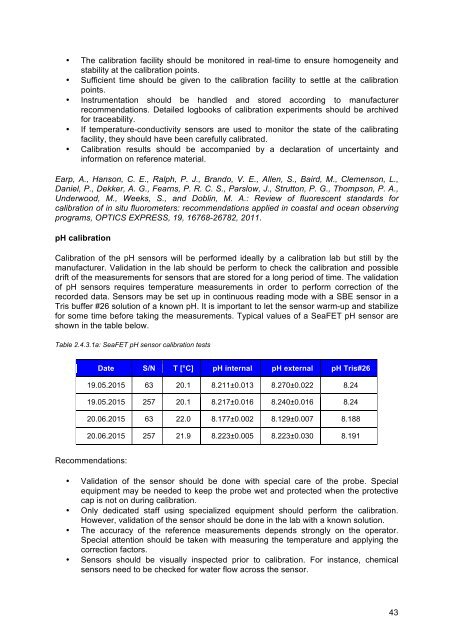Handbook of best practices
Handbook%20of%20best%20practices
Handbook%20of%20best%20practices
You also want an ePaper? Increase the reach of your titles
YUMPU automatically turns print PDFs into web optimized ePapers that Google loves.
• The calibration facility should be monitored in real-time to ensure homogeneity and<br />
stability at the calibration points.<br />
• Sufficient time should be given to the calibration facility to settle at the calibration<br />
points.<br />
• Instrumentation should be handled and stored according to manufacturer<br />
recommendations. Detailed logbooks <strong>of</strong> calibration experiments should be archived<br />
for traceability.<br />
• If temperature-conductivity sensors are used to monitor the state <strong>of</strong> the calibrating<br />
facility, they should have been carefully calibrated.<br />
• Calibration results should be accompanied by a declaration <strong>of</strong> uncertainty and<br />
information on reference material.<br />
Earp, A., Hanson, C. E., Ralph, P. J., Brando, V. E., Allen, S., Baird, M., Clemenson, L.,<br />
Daniel, P., Dekker, A. G., Fearns, P. R. C. S., Parslow, J., Strutton, P. G., Thompson, P. A.,<br />
Underwood, M., Weeks, S., and Doblin, M. A.: Review <strong>of</strong> fluorescent standards for<br />
calibration <strong>of</strong> in situ fluorometers: recommendations applied in coastal and ocean observing<br />
programs, OPTICS EXPRESS, 19, 16768-26782, 2011.<br />
pH calibration<br />
Calibration <strong>of</strong> the pH sensors will be performed ideally by a calibration lab but still by the<br />
manufacturer. Validation in the lab should be perform to check the calibration and possible<br />
drift <strong>of</strong> the measurements for sensors that are stored for a long period <strong>of</strong> time. The validation<br />
<strong>of</strong> pH sensors requires temperature measurements in order to perform correction <strong>of</strong> the<br />
recorded data. Sensors may be set up in continuous reading mode with a SBE sensor in a<br />
Tris buffer #26 solution <strong>of</strong> a known pH. It is important to let the sensor warm-up and stabilize<br />
for some time before taking the measurements. Typical values <strong>of</strong> a SeaFET pH sensor are<br />
shown in the table below.<br />
Table 2.4.3.1a: SeaFET pH sensor calibration tests<br />
Date S/N T [°C] pH internal pH external pH Tris#26<br />
19.05.2015 63 20.1 8.211±0.013 8.270±0.022 8.24<br />
19.05.2015 257 20.1 8.217±0.016 8.240±0.016 8.24<br />
20.06.2015 63 22.0 8.177±0.002 8.129±0.007 8.188<br />
20.06.2015 257 21.9 8.223±0.005 8.223±0.030 8.191<br />
Recommendations:<br />
• Validation <strong>of</strong> the sensor should be done with special care <strong>of</strong> the probe. Special<br />
equipment may be needed to keep the probe wet and protected when the protective<br />
cap is not on during calibration.<br />
• Only dedicated staff using specialized equipment should perform the calibration.<br />
However, validation <strong>of</strong> the sensor should be done in the lab with a known solution.<br />
• The accuracy <strong>of</strong> the reference measurements depends strongly on the operator.<br />
Special attention should be taken with measuring the temperature and applying the<br />
correction factors.<br />
• Sensors should be visually inspected prior to calibration. For instance, chemical<br />
sensors need to be checked for water flow across the sensor.<br />
43


